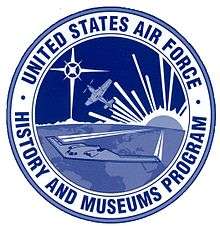Air Force History and Museums Program
 | |
| Established | 1947 |
|---|---|
| Location | Worldwide |
| Coordinates | 39°46′55″N 84°06′32″W / 39.781976°N 84.108892°W |
| Director | Mr. Walter A. Grudzinskas, Acting Director |
| Website | http://www.af.mil/information/heritage/links.asp |
The United States Air Force History and Museums Program exists to improve combat capability through the collection, preservation and display of Air Force information and artifacts. The current Acting Director is Mr. Walter A. Grudzinskas.
Mission
The mission of the Air Force History and Museums Program is to improve combat capability through the collection, preservation, interpretation, dissemination and display of historical information, artifacts and AF heritage to commanders and the public.
The worldwide history program consists of more than 200 Air Force historians. They write the annual wing, numbered air force and major command histories that document all Air Force activities.
The Office of Air Force History (AF/HO), located at the Pentagon, Arlington, VA, provides policy, guidance, and advocacy for the worldwide program.
The Air Force Historical Studies Office (AF/HOH)located on Joint Base Anacostia Bolling, Washington, DC., is the book writing element of the history program. It researches, writes, and publishes historical books, monographs, and special studies, and provides historical informatrion and research assistance primarily in support of the Air Staff.
The Air Force Historical Research Agency (AFHRA), located at Maxwell Air Force Base, Ala., maintains the 100+ million pages of official Air Force archives.
The National Museum of the United States Air Force at Wright-Patterson AFB, Ohio, which hosts more than 1.5 million visitors a year, collects, restores and displays air and space craft, a legacy that spans more than a century of military flight.[1]
Air Force historians
Air Force historians work at every level of the Air Force command structure, collecting information within their organization. Echelons down to the wing (and some groups) have formal historian positions, echelongs below the wing have members who perform historian work as an additional duty. Today, historians are Department of the Air Force historians, while the United States Air Force Reserve maintains enlisted historians.
Background
In 1943, the U.S. Army Air Forces established the Historical Division under the Assistant Chief of Air Staff for Intelligence to gain an accurate and objective account of World War II experiences. Since then, historians have been responsible for creating official records of each echelon of the Air Force, from individual squadrons to the Department of the Air Force.
Duty position
Around 2005, most uniformed Historian positions--Air Force Specialty Code 3H0X1—were replaced by civilian government service positions, sometimes held by individuals who previously worked as 3H0X1 while in uniform but then retired or separated. Both types of historian, uniformed and civilian, can be deployed to an expeditionary unit to collect data and record events as they occur. Historians have been deployed during Operations Allied Force, Desert Shield/Desert Storm, Iraqi Freedom and Enduring Freedom. Historians have also deployed in support of humanitarian operations. While it was an enlisted position in uniform with no education requirement, the civilian position requires a degree in History, or a similar degree with 18 credit hours in history.
General responsibilities
Air Force historians maintain the Air Force legacy. During combat operations, they provide information and analysis for current operations as well as records and interpretation for when the operation ends. While obviously useful in recording wartime data, they also record peacetime operations, such as humanitarian relief missions, bringing food and medical supplies to disaster areas, or training events that lead to better mission capabilities.[2]
Higher-headquarters historian duties
Higher-headquarters historians help provide historical perspective to assist decision makers and commanders. They provide data for manning authorization plans, environmental studies, or decision-making scenarios. They are also responsible for managing collection and compilation of subordinate unit histories.
Lower-Echelon historian duties
At squadron and wing echelons, historians compile perishable information such as combat records and data. They can conduct post-combat mission interviews, document significant achievements or events and prepare studies on special topics. Their main responsibility lies in creating annual narratives and an official record of the unit's accomplishments.
References
- ↑ https://www.my.af.mil/gcss-af/USAF/ep/contentView.do?contentType=EDITORIAL&contentId=c6925EC1960610FB5E044080020E329A9&channelPageId=s6925EC13550C0FB5E044080020E329A9&programId=t6925EC2BF1060FB5E044080020E329A9
- ↑ http://www.af.mil/news/story.asp?id=123099455
